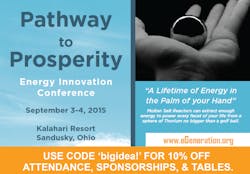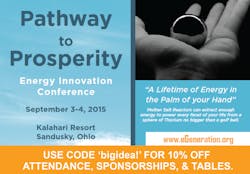Get Ready for Clean Energy from New Nuclear
You already know that low-cost, clean, affordable, and abundant energy is the silver bullet to solving some of the world’s biggest problems. If we had this type of energy, we could solve issues like clean water, waste water treatment, municipal waste disposal, fertilizer production, food and agriculture resources, as well as hazardous waste management.
Let’s not forget one of the biggest problems at hand – expanding populations in third world nations competing for resources. Affordable energy can help heighten the quality of life for a massive amount of people. Dr. William Thesling, founder and Executive Chairman of eGeneration Foundation says China is a great example of how energy can effect a nation. "China’s energy policies have literally lifted millions of its people out of poverty (more than the population of the western hemisphere). But, China is still struggling to maintain its air quality and its environment."
Speaking of the environment...the war on climate change is picking up pace as world leaders prepare to meet in Paris this winter. President Obama is said to release the Clean Power Plan as early as this Monday. And, it was announced today by the White House that some of America's most influential companies like Walmart, Cargill, GM, Alcoa, Apple and more have made statements of drastic reductions in their carbon footprint through the American Business Act on Climate Pledge. Most of the companies state they will use renewable energy technologies as the answer.
But, imagine if businesses and consumers had access to energy that was affordable and virtually pollution free -- would renewables still be the answer?
Not Your Father's Nuclear
Molten Salt Reactors (MSRs), which Machine Design Editor, Steve Mraz, covered back in 2010, was proven viable back in the mid 1960’s but was never commercialized. From the information at hand, MSRs seem to create the closest form of a silver bullet of reliable, accessible, and clean energy. Yet, even though MSR technology is a United States creation, the US is one of the few super-powers that is NOT rushing to commercialize the technology.
But don’t fret, technology like the MSR is just a few passages of legislation away from becoming a household name.
Individual states are starting to promote MSRs and coming together collectively to nudge Congress. Ohio is the first state on board with the (almost unanimous) passing of HCR-9. Plus, just this week, the state of Washington passed a bill for small modular reactors (SMR).
Of course, SMRs don’t necessarily mean MSRs. SMRs also include our everyday type of nuclear operations in a scaled down design. SMRs have the advantage that they could be assembly-line manufactured much like how Washington’s local bigwig Boeing manufactures commercial aircraft. But, future generation MSR designs could be modular enough to be shipped on a flatbed semi! These modular MSRs would be great for devastation areas, industrial parks, and of course third-world countries.
There are roughly three or more states that are in the process of promoting MSR to solve their local challenges:
- Maine with LD 1116
- Illinois with HB 3293
- North Dakota with HB 1190 to be reintroduced in the next session
- Interest from California, South Carolina, and Alabama
And, the momentum grows with the announcement of two events coming up that will help educate and further explain MSR tech:
- Policy Briefing: The development and commercialization of next generation nuclear technologies including Liquid Core Molten Salt Reactors. August 11th in Washington D.C. Cost is Free.
- Path Pathway to Prosperity: Energy Innovation Conference. September 3-4, 2015 in Sandusky, Ohio. This two-day event will give the big picture about the benefits and limitations of MSR. Costs vary, but you can use discount code ‘bigidea!’ to get 10% off attendance tickets, sponsorships, or tables.
I personally don’t see any problems with using MSR. I'm pretty excited about this technology yet kind of frustrated that it hasn't commercialized in the US. I mean, imagine the possibilities! What could you design and manufacture with energy from MSR? And most importantly, what problem could you solve?
But I don’t want to keep writing about a technology that doesn’t meet the needs of the world. So, I need your help in understanding the full spectrum of the effects of building and using MSRs. I want to know your opinions, expertise, and concerns. Don’t be shy. Please voice your thoughts and questions in the comments section below or share this article with your networks.
Until next time, keep thinking BIG!
Lindsey Frick @BigIdeaEngineer
About the Author
Lindsey Frick - Big Idea Engineer
Strategist & Social Entrepreneur
Lindsey Frick is a Mechanical Engineer and Entrepreneur who develops strategies and ideas to solve big problems. She shares her research and experience on new technologies, materials, processes, funding models, and new markets in hopes to inspire other engineers and designers to think big.
Follow her on twitter @BigIdeaEngineer

